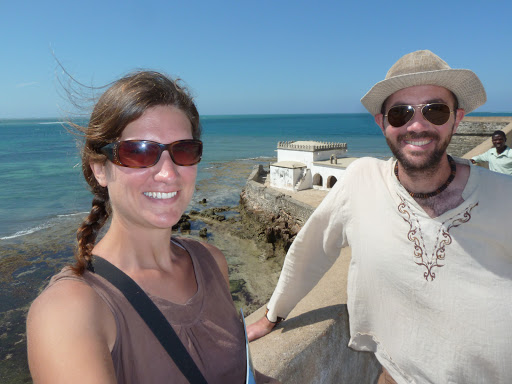Since 1991, Mozambique Island (or Ilha De Moçambique in the Portuguese tongue) has been a UNESCO World Heritage Site, and is considered one of the must-see-destinations in northern Mozambique. A former Arab port and trading centre, and the capital of Portuguese East Africa for several centuries, this tiny island is steeped in history and Jennie and I were most eager to explore it.
Arriving at our first guest house following a 40-hour journey (chronicled by Jen in the previous entry) we decided for one night only to ignore the fact that the price was a little high and instead pretend that we were one of the island's 17th century gold traders by treating our sleep-deprived selves to a room that looked like this.
The only things missing were a swathe of servants and incalculable wealth. I asked for both. I received neither. Meh. Still, it was a lovely place and for dinner that night we treated ourselves to the local speciality called matapa - cassava leaves cooked in a peanut sauce - which was nothing short of delicious.
Nice as that room was, for cost reasons we had to move to a different place the next morning and what a place we moved to - Ruby Backpacker is an absolute gem. An intimate little travellers haven that I'd liken to a Moroccan Riad, it had a great rooftop terrace, a good bar and an absolutely brilliant kitchen - the Portuguese owner, Claudia, has brought real Mediterranean style to it and stocked with herbs, spices and oils unheard of in most backpacker establishments. To top it all, she bakes a daily cake treat - it's sublime.
Difficult as it was to actually leave Ruby, the old colonial part of the island, known as Stone Town, awaited us. Having already tasted Kenya's Lamu and Tanzania's Zanzibar, we were really interested to see how Mozambique's equivalent stacked up. What instantly strikes about Mozambique Island is how much quieter it is than the other two - its days as a place of real influence are long, long gone and now it is something of a ghost town with many of the old villas and mansions left crumbling, next to others which have been lovingly restored. This gives the place a rather haunting feel, and is particularly engaging.
We visited a number of particularly grand structures. First was the old Governor's palace and its accompanying maritime and sacred art museums, as well as the on-site chapel and nearby whitewashed Church of the Misericordia. The maritime museum was particularly interesting - such was the strategic importance of Ilha De Moçambique as a trading port that ships from all over the world would stop here, as the collection of fantastically well preserved Ming Dynasty porcelain from a nearby Chinese shipwreck attested to.
The most prominent building on the island is also the largest - the massive Fort of Sao Sebastao, which is in fact the oldest complete fort still standing in sub-Saharan Africa, construction having started in 1558 and taking more than 50 years to complete.
It's tremendously impressive and very well preserved, and standing in the grounds or on the ramparts it was easy to imagine the grandeur of the place in its heyday as it dominated the northern end of the island and the sea port beyond. Much smaller, though equally impressive in its own way was the little Chapel of Nossa Senhora de Baluarte, just beyond the fort, which having been built in 1522 is said to be the oldest European building in the Southern Hemisphere.
This day of exploration also came with an added bonus - well, two added bonuses called James and Sam. James is a doctor and Sam a physio who have been living and working in Malawi and are on a final holiday before they head back to the UK to get married (just weeks before we do, as it turns out). We struck up conversation with them around the Governor's palace and continued at the fort, and before long we were downing afternoon beers at their (stunning) hotel and making plans for dinner together that evening.
As it turned out, the two of them had to leave the following morning, but they were a fantastic pair, and we hope very much to catch up with them back in London.
As it also turned out, we'd done the right thing by getting the majority of our sightseeing done already, because the next day the heavens opened and the rains came. Not that this was a particular problem for us - Ruby was the perfect place to spend a rainy day at the bar drinking beer, eating Claudia's baked treats and then later settling in our room to watch a couple of films on the trusty laptop. Seriously, this backpacking lark is sodding hard work.
So it's another early start tomorrow as we head still further north - Pemba, Ibo and the Quirimbas Archipelago await us as our final Mozambican adventures.
Things Jennie will remember:
1) Visiting the market and being surprised by the honest prices and how low they were!
2) The garlic prawns we ate and James' and Sam's hotel
3) The Millennium Bank which on the inside still has the old 1920s style metal bars between customer and clerk, complete with wooden storage draws. It's beautiful.
4) The peanut balls that Sean loved and I thought were far too sickly sweet
5) The small fiasco with our laundry and the rain, it finally dried out just before bedtime
Here are the photos:















No comments:
Post a Comment